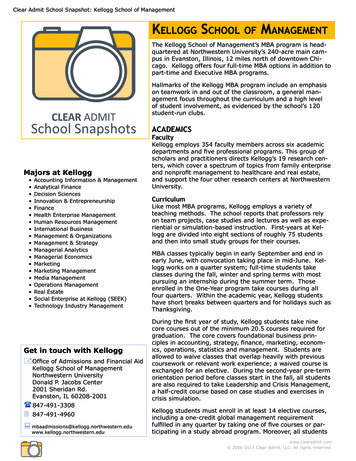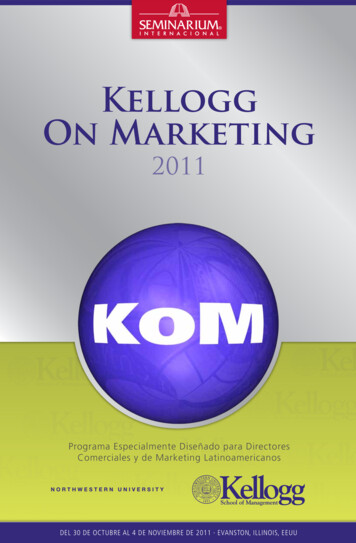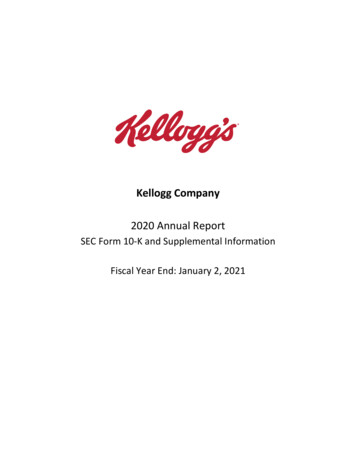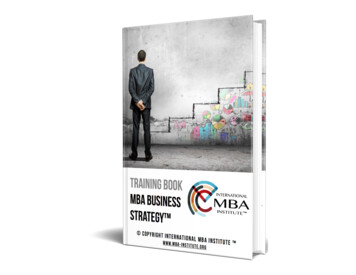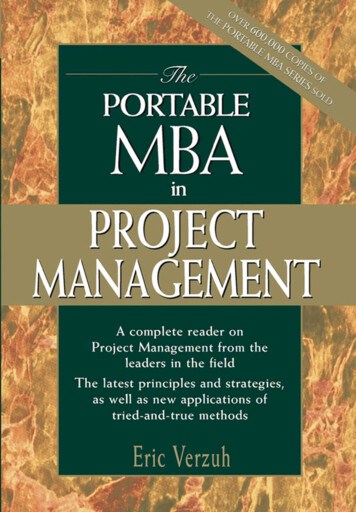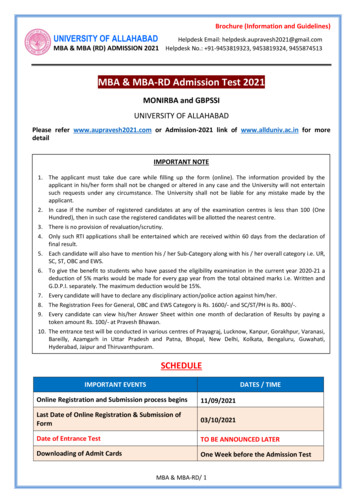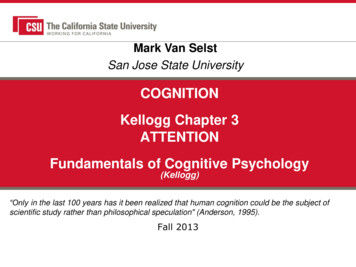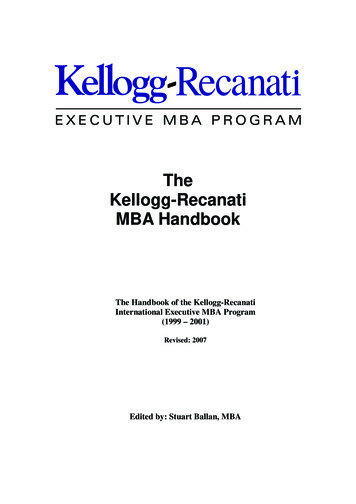
Transcription
TheKellogg-RecanatiMBA HandbookThe Handbook of the Kellogg-RecanatiInternational Executive MBA Program(1999 – 2001)Revised: 2007Edited by: Stuart Ballan, MBA
DEDICATIONThe Kellogg-Recanati MBA Handbook is dedicated to the spouses, children and friends of theKR04 students, who for two years, have (usually) tolerated the absence of their husband, wife,father, mother and friend!THANKS FROM THE KR04 STUDENTS .Thanks to our sponsors, who committed to, funded and supported our studies throughout the twoyear course.Thanks also to the administration team of the Kellogg-Recanati Executive MBA program, whofor 2 years, looked after us, beyond the call of duty.Thanks to the KR04 students who volunteered their time to summarize individual courses, andto the Professors of those courses, who together, effectively acted as an Advisory Committee tothis publication, by magically finding time in their busy schedules to carefully andcomprehensively review the course summaries, and provide feedback, in order to ensure thequality of this Kellogg-Recanati MBA Handbook is of the highest possible.Finally, on a personal note, thanks to my wife, Dorit, for encouraging me to make this KelloggRecanati MBA Handbook happen, and for supporting me, whilst I made it happen.USEFUL WEBSITESKellogg School of Management ti Program http://kr-emba.tau.ac.il/Kellogg-Recanati MBA Handbook http://www.kr04.netKellogg-Recanati Alumni Club timideast/Original: November 2001 - Published in print formatRevised: July 2007- Updated “Introduction” and released in PDF format.Copyright 2001-7 by the “KR MBA Handbook Contributors”, as summarized in Appendix B.All rights reserved. No part of this book may be reproduced, in any form or by any means, withoutwritten permission from the Editor.Kellogg-Recanati MBA Handbook - Page ii
TABLE OF CONTENTSIntroductionProfessorPageIntroduction . . ivHow the Kellogg-Recanati MBA Handbook is organized . v1. Marketing1.11.21.31.4Strategic Marketing .International Marketing Channels .Marketing Strategy .Market Research .Lakshman Krishnamurthi . 1Anne Coughlan . 7L. Krishnamurthi & G. Carpenter . 11Dipak Jain . 162. Accounting2.1 Financial Info. for Management Planning & Control . Bala Balachandran 202.2 Financial Reporting Systems Dan Givoly 273. Finance3.13.23.33.43.5Managerial Finance . Aharon (Roni) Ofer . 33Security Analysis . Thomas Lys . 38International Economics & Finance . Avner Kalay . 43Financial Analysis & Valuation Eli Amir 47Integration with the Finance Function . Arthur Raviv . 534. Organizational Behaviour4.14.24.34.4Managing Individuals & Groups in Organizations . Brian Uzzi . 59Negotiations . Jeanne Brett & Leigh Thompson . 64Organizational Design & HRM . Orly Yehezkel . . 70Leadership & Ethics . David Messick . 755. General Management & Strategy5.15.25.35.45.55.65.7Operating Strategies for the General Manager . Margaret Peteraf . 79Operations Management Eitan Zemel . 83Information Systems Management Gadi Ariav 87International Business Law . Moshe Bar Niv . 91Profitable Pricing Strategies & Tactics .Meir Karlinsky . 94Strategic and Managerial Decisions . Dov Samet 98International Business Technology Transfer . Daniel Rouach . 1046. Business Economics6.1 Managerial Economics .Jacob (Kobi) Glazer . 1126.2 Macroeconomics environment in the Middle-East Asher Tishler 1156.3 Competitive Strategy & Industrial Structure . Nabil Al-Najjar . 1187. Statistical Decision7.1 Analytical Approach to Uncertainty . Itzhak Gilboa 1217.2 Statistical Decision Analysis .Jacob Zahavi . 126AppendicesA. The KR04 Professors . 130B. The Kellogg-Recanati MBA Handbook Contributors . . 131Kellogg-Recanati MBA Handbook - Page iii
INTRODUCTIONI still clearly remember the KR02 class representative addressing theaudience at KR02’s graduation ceremony, in late 1999. “For every course,I put a piece of paper in my pocket, containing key messages from thatcourse”, he said.Sitting there in the audience, about to embark on the new Kellogg-RecanatiKR04 International Executive MBA program, the most prestigious MBAavailable in the Middle-East and one of the top business courses availablein the world, I really could not relate to why on earth he’d want to do that.A year later, halfway through our 2-year program, I understood. The volume of information inthe first year had been huge. Class material from the middle of the year now seemed, well, alittle confused and vague, whereas class material from the beginning of the year was closer to adistant memory!In order to maximize my long-term benefit of the EMBA program, I wanted to capture the mainpoints of each of the 27 courses of the KR04 program, before it was too late. I assumed that if Ineeded such a summary, then so would others. I certainly knew that there was no realistic way Iwould be able to summarize 27 courses myself!The Kellogg-Recanati MBA Handbook grew out of this common need. Many KR04 studentsvolunteered their time to summarize 1 and sometimes 2 courses each. It was decided that foreach course, there would be a 1 page summary, typically containing 5 key points to “take home”from the course, (analogous to the “piece of paper in my pocket”, discussed above), and a moreverbose description of the course, of about 3 to 5 pages in length. A process was put in place toensure quality was maintained, by securing the services of the respective course Professors, whoeach agreed to review the course summaries and to comment if needed, to ensure the contentwas accurate and of the highest possible quality.The Kellogg-Recanati MBA Handbook was written “by the students, for the past, current andfuture students, with quality approved by the professors, and with the full support of DeanDipak Jain”. The print version was distributed at the graduation ceremony of the class of KR04in November 2001, was sent to all KR alumni, to all course professors, and far beyond. The fullcontent was also published on the web at www.kr04.net, and since November 2001 has becomestandard reference material for over 125,000 visitors, spanning over 40 countries, enjoyingsignificant local and international visibility and press as a result.Even though the stock of print copies of the Kellogg-Recanati MBA Handbook have long sincebeen exhausted, the demand for print copies continues 6 years after publication. It was to meetthis demand that this 2007 special version of the handbook has been published, in PDF format.My thanks to all who contributed to this handbook. Without your help, this handbook would nothave been possible. Finally, consistent with the original objective of this handbook, I hope youfind it a useful source of reference for years to come.RegardsStuart Ballan, MBAEditor, The Kellogg-Recanati MBA HandbookPresident, Kellogg-Recanati Alumni Club of the Middle-EastMember, Kellogg Alumni Advisory BoardStuart@msisrael.netKellogg-Recanati MBA Handbook - Page iv
HOW THE KELLOGG-RECANATI MBA HANDBOOK IS ORGANIZEDThe 27 courses of the International Kellogg-Recanati Executive MBA fit into any oneof 7 sections, as summarized nizational BehaviorGeneral Management & StrategyBusiness EconomicsStatistical Decision.The KR MBA Handbook includes a course summary for each of these courses,organized within the above 7 sections. A summary of all the 27 courses, and where theyfit, can be found in the Table Of Contents.To help you find courses quickly within this handbook, look up the course in the Tableof Contents, for example, you’ll find “Market Research” as course 1.4, starting onpage 16. You can then either look for the correct page number, or “flick” through thehandbook, looking for the following graphics on the top right hand corner of each page:1.4You should be able to find any course very quickly, using this method.Each course summary consists of a single “Summary page”, being the high-level pointsthat should be taken away from each course. In addition, each course summary consistsof between 3 to 6 “Detail pages”, offering a more verbose explanation of the pointscontained in the “Summary page”. You can look underneath the course number to seewhere you are within a course; Either a summary page, or, say, “Detail page 2 of 3”It should be noted that the course summaries are not intended to replace the wealth ofknowledge available via the respective course textbooks, class notes and of course,course attendance. They are, however, intended to be a quick and portable referenceguide for the most important points of all the 27 courses, providing accurate, relevantand quality checked information. As the Kellogg-Recanati MBA Handbook is alsoavailable on the web at www.kr04.net, the web version offers readers “the informationyou want, when and where you want it”. Readers wishing to look deeper into a givensubject can use the Kellogg-Recanati MBA Handbook as an index into the text booksand class notes, distributed throughout the 2 year course.Finally, as Dean Jacobs told the class on our opening day, we should “work hard andhave fun”. We certainly did!Kellogg-Recanati MBA Handbook - Page v
Section 1: MarketingStrategic Marketing – Professor Lakshman Krishnamurthi1.1Summarised by: Michel Ben Oliel, MBASummarypageSUMMARY PAGE1. Marketing is everything and everything is marketing2. Sustainable Customer AdvantageYou have customer advantage when customers value the benefits you provide, are willingto pay for them, and believe you are the one best able to deliver those benefits. Assets andskills provide the basis for a sustainable customer advantage.3. The 4 P’s of marketing tools are: Product, Price, Promotion, Place4. SegmentationA segment consists of a group of entities that share something in common. Usage,demographics, Geography, psychographics and benefits are used as bases for segmentation.A segment must be identifiable, significant, accessible and responsive.5. Targeting and positioningSelect and prioritize the segments to go after where you have customer/competitiveadvantage. Understand who is your target, who are your competitors and what is your pointof difference.6. New Market strategiesThe objectives are to (1) attain first mover advantage through pioneering, (2) enter newsynergetic markets, (3) preempt competition, (4) increase product offering and (5) defendyour current position.7. First Mover advantagePioneers have the opportunity to shape customer preferences, preempt positioning andpotentially increasing switching costs to later entrants products.8. Late entry strategyYou need late entry strategy to survive, grow and influence the market. Small scalepenetration you use fringe, me-too, niche and premium strategies. For large scale you usedifferentiation, challenger, penetration strategies.9. Pricing strategies Of the 4 P’s, price is the only one that produces revenues; the other three P’s producecosts. Cost, competition, customer value or the channel may drive pricing strategies. The pricing process consists of collecting data and information, making pricingdecisions, communicating the prices, analyzing the responses of the customers,competitors, monitoring and evaluating the strategy.10. Service quality Customers perceive Service quality as the extent of discrepancy between customer’sexpectations or desires and their perceptions of actual service performance. The key is to meet or better exceed what customers expect from the service. Customerexpectations are influenced by past experience, word-of-mouth, personal needs andboth direct and indirect messages and prices. To judge service quality, customers use dimensions such as tangibles, reliability,responsiveness, assurance and empathy. There are 4 gaps contributing to poor QOS (1) Not knowing what customer expect (2)Setting the wrong QOS standards (3) The service performance gap (4) Discrepancybetween actual service delivery and what is communicated about it.Kellogg-Recanati MBA Handbook - Page 1
Section 1: MarketingStrategic Marketing – Professor Lakshman Krishnamurthi1.1DetailPageDETAIL PAGESDefinitionsWhat is marketing?“Marketing is everything and everything is marketing”. Marketing is:1. Identifying what customers want.2. Translating those needs into actionable product/service attributes.3. Communicating to R&D/production/manufacturing.4. Communicating product/service offering to customers.5. Influencing customer preferences promotional activities.6. PR and eCommerce support.7. Selecting the right channels for distribution.Marketing MixThe set of marketing tools that a firm uses to pursue its marketing objectives in a targetmarket. The four P’s of marketing are:1. Product – variety, quality, design, features, packaging sizes, services, warranties andreturns.2. Price – List price, discounts, allowances, payment period and credit terms.3. Promotion – sales promotion, advertising, sales force, PR and direct marketing.4. Place – channels, coverage, assortments, locations, inventory and transport.Customer Value – 3 types of benefitsValue is defined as the perceived worth in monetary units of the set of economic,functional/technical, and psychological benefits received by the customer in exchange forthe price paid for a product offering taking into consideration available competitive offeringand pricing.Customer advantage Customers are value-maximizers. They form an expectation of value and act on it.Buyers will buy from a firm that they perceive to offer the highest customer deliveredvalue, defined as the difference between total customer value and total customer cost. Marketing is delivering on customer advantage. You have customer advantage whencustomers value the benefits you provide, are willing to pay for them, and believe youare the one best able to deliver those benefits. You use assets and skills to attain asustainable customer advantage. You need competitive advantage to be a player and tomake the sale but customer advantage helps you make the margin. Consequently,customer advantage is more critical than competitive advantage. Sellers must assess the customer value and cost associated with each of theircompetitors to know how their own offer stacks up. Sellers in who are at a deliveredvalue disadvantage can try either to increase total customer value or to lower totalcustomer cost. A buyer satisfaction is a function of the products perceived performance and the buyerexpectations. Companies use Total Customer Satisfaction (TCS), both as a goal and amarketing tool.Kellogg-Recanati MBA Handbook - Page 21 of 5
Section 1: MarketingStrategic Marketing – Professor Lakshman Krishnamurthi1.1DetailPageTarget Marketing Target marketing involves three activities: segmentation, targeting and positioning. Markets can be targeted at 4 levels: segments, niches, local areas and individuals.Market segments are large identifiable groups within a market. Marketers localize theircampaigns for trading areas, neighborhood and individual stores. There are two bases for segmenting consumer markets: consumer characteristics andconsumer responses. As it is not easy to segment directly on benefits, so it is often simpler to start withdirectly observable variables such as: size/type of industry/firm/operationalcharacteristics / demographics, etc, and then obtain data that delineates benefits.Segment Benefits Product features/ service levelsDistribution Communication,etcThe major segmentation variables for consumer markets are geographic, demographic,phsycographic and behavioral. These variables can be used singly or in combination.To be useful, market segments must be measurable, substantial, accessible,differentiable, and actionable.Once a firm has identified its market-segments opportunities, it evaluates the varioussegments and decide how many and which ones to target. The choice can be a singlesegment, several segments, a product or the full market. When choosing the fullmarket, it must choose between differentiated and undifferentiated marketing.Positioning Positioning is delivering on customer advantage and creating a bond between thecustomer mind and your product. To successfully position a product, the product mustbe in the consideration set and there must be a point of difference. In other words:o Customer has to know you (awareness)o Customer has to like youo Customer has to choose you (meaningful point of difference) Positioning statement summarizes the essence of competition and differentiationo Who is your targeto Who are your competitors (implicitly or explicitly)o What is your point of difference? What is your reason for being There are many ways of positioning:o Attribute basedo Focus on benefits (economic, functional and psychological)o By Useo By User/Lifestyleo By product classo Against competition (Hertz versus Avis)o Country or Geographic areaDifferentiationThe key to competitive advantage is product differentiation. Differentiation is worthestablishing to the extent that it is important, distinctive, superior, preemptive, affordableand profitable. Products can be differentiated along 5 dimensions:1. Product (form, features, performance and conformance qualities, durability,reliability, repairability, style, design)2. Services (ease of ordering, delivery, installation, training, consulting, maintenanceand repair)Kellogg-Recanati MBA Handbook - Page 32 of 5
Section 1: MarketingStrategic Marketing – Professor Lakshman Krishnamurthi1.1DetailPage3. Personnel4. Channel5. Image (symbols, media, atmosphere and events)“Points of difference” can be achieved through the 3 value disciplines:1. Operational excellence – providing customers with reliable products, at competitiveprices, with the least inconvenience2. Customer intimacy – providing products and services that uniquely meets customerneeds.3. Product leadership – offering customers products and services that are superior tothe competition, constantly innovating and keep raising the bar.New product strategyThe objectives of a new product strategy are to attain first mover advantage throughpioneering, preempt competition, increase product offering and defend your current position.A new product strategy can be Market driven or Market driving. A Company adds newproducts through acquisition or development. There are 6 categories of new products:1.2.3.4.5.6.New-to-the-world products that create an entirely new marketNew product lines allowing a company to enter an established market for the first time.Addition to existing product lineImprovement or revisions of existing productsRepositioning of existing products by targeting new markets or segmentsCost reduction – new products that provide similar performance at reduced cost.Pioneering Strategy - First Mover advantageThe objectives of a First mover are to define/establish the rule of the games. Pioneershave the opportunity to gain pioneer advantage in 3 ways:o Shape customer preferences,o Preempt positioningo Potentially increasing switching costs to later entrants products.They do it by:o Educating customers about benefits/features.o Reduce the uncertainty about product and technologyo Influence customer preferences toward product supplied by pioneer.o Frame perceptions of late entrantsLate entry strategyYou need late entry strategy to survive, grow and influence the market. For small scalepenetration you use fringe, me-too, niche and premium strategies. For large scale you usedifferentiation, challenger, penetration strategies. The options are to compete with similaremphasis, change the emphasis of competition, or change the rules of competition.Pricing strategiesPricing is an integral element of marketing strategy and should be consistent with overallstrategic objectives. To effectively translate pricing strategy into actual prices requires apricing process that is fact-based, monitored and updated. Of the 4 P’s, price is the only onethat produces revenues; the other three P’s produce costs.Kellogg-Recanati MBA Handbook - Page 43 of 5
Section 1: MarketingStrategic Marketing – Professor Lakshman Krishnamurthi1.1DetailPageFour Pricing approaches:1. Cost-driven – focuses on estimating costs and adding on a preset margin. It does notuse any marketing input.2. Competition-driven – focuses on competitors prices. It encourages price competitionand ignores product differentiation. Might trigger price wars and dilute values.3. Customer-value-driven - focuses on what is the worth of the product to the customer ifit offers solutions to their problems. It is driven by marketing and sales and is a crossfunctional approach.4. Channel-driven – focuses on the incentive for the channel member to carry the productSix steps Pricing Process:1. Data collection Internal data (costs/margins/profits) Competition (prices , margins, elasticity) Customers data (elasticity, product evaluation)2. Information – use statistics, reports and expert systems to analyze history of prices,volumes and profit3. Pricing decisions How pricing decisions integrate with marketing and corporate strategies. What rules will be used to set price for a product/line.4. Execution Providing and communicating the pricing decisions to customers and distributors. Signaling price changes to competitors.5. Market response – monitor and analyze responses from Customers, Distributors andCompetitors6. Monitoring and evaluation Monitor sales, margins and profit Monitor customer retention percentage Analyze competitive pricing versus own pricing. Track competitors’ responses to pricingCustomer service qualityService quality, (QOS), is perceived by customers as the extent of discrepancy betweencustomer’s expectations or desires and their perceptions of actual service performance.The key is to meet or better exceed what customers expect from the service. Customerexpectations are influenced by past experience, word-of-mouth, personal needs and bothdirect and indirect messages and prices. To judge service quality, customers use dimensionstangibles, reliability, responsiveness, assurance and empathy.Four gaps contributing to poor Quality of Service (QOS): Gap 1 – Not knowing what the customer wants - The discrepancy between customers’expectations and management perceptions of these expectations. The key to reducing itis to know what customer expect by thinking OUTSIDE IN. Customer expectationscan be researched through (1) complaints, (2) similar industries and (3) customerintermediates (employees, dealers, distributors) (4) key-client studies (5) customerpanels (6) tracking satisfaction with individual transactions (7) comprehensivecustomer-expectation studies Gap 2 – Not setting the right standards - Setting the wrong QOS standards. Resourceconstraints, short-term profit orientation, market conditions, perception of infeasibilityor management indifference may be the cause. Gap 2 may be closed using hardtechnology such as information databases, automating tasks and scheduling or deliverysystems.Kellogg-Recanati MBA Handbook - Page 54 of 5
Section 1: MarketingStrategic Marketing – Professor Lakshman Krishnamurthi1.1DetailPage Gap 3 – Not delivering on the standards - The difference between the servicespecifications and the actual service delivered. May be caused by role ambiguity, roleconflict, employee-job fit, technology-job fit, and teamwork.Gap 4 – Not delivering on the promises - When promises to customers do not matchdelivery. Gap 4 may be caused by inadequate horizontal communications or a tendencyto over promise. Effective communication about QOS must (1) deal with the qualitydimensions of features that are most important to the customers, e.g., reliability; (2)accurately reflect what customer actually in the service (3) help customer understandtheir role in performing the service.Communication can be used to manage customer expectationsService tenets to live by Seek constant improvement Forget about being in a commodity business Do the service right the first time Do the service very right the second timeSummary of course CasesEMI CaseThe concept of benefits was used to discuss the EMI case and how EMI could havepositioned itself.Sealed Air CaseThis case considered whether or not the company should market an uncoated bubble, andhow to limit cannibalizationThe Calyx & Corolla CaseThis case allowed an entrepreneurial business to be considered. It is a great idea but whenan STP was done, and focused on who values the benefits that C&C provides, it becameclear that the benefits mattered only to some sub-segments, and on awareness 1-800FLOWERS dominated C&C.Kodak Funtime Film CaseThis case discussed the following issues: Should Kodak launch Funtime? Does it hurt theirbrand? Can they prevent share slippage? How do they manage cannibalization?The Rohm & Haas caseThe company did not understand that the customer with small tanks, who is typically asmall machine tool operation, is very different from the large customers, who are familiarwith biocides. The channel structure that was optimal for large customers needed to berethought for the new market. Different pricing options were considered: Cost-pluspricing, pricing based on competition, pricing to incentivize the formulators to sell thebiocide, and a price based on customer value. A critical problem with the MWX biocidewas positioning: both a lack of awareness and a point of difference that was understood bythe customers. This meant education would be necessary. Under the current pricingstructure there is no incentive for any channel member to provide education. A price flowthat could help to educate the customer was outlined, and some options that R&H couldpursue were discussed.Kellogg-Recanati MBA Handbook - Page 65 of 5
Section 1: MarketingInternational Marketing Channels – Professor Anne Coughlan1.2Summarised by: Asher Gabbay, MBASummarypageSUMMARY PAGE1. Definition of Marketing ChannelA marketing channel is a set of independent organizations involved in the process ofmaking a product or service available for use or consumption. Channels involve manyorganizations (intermediaries), are a process and focus on end-users.2. Channel FlowsA marketing channel performs marketing flows. The flows are: Physical possession,Ownership, Promotion, Negotiation, Financing, Risking, Ordering and Payment.3. Zero-based ChannelA zero-based channel meets the service output demands (SODs – what the end-usersdemand) at a minimum cost of performing the channel flows necessary for to meet theseSODs.4. Equity PrincipleThe equity principle states that compensation in the channel system should be given on thebasis of the degree of participation in flows and value created.5. Channel PowerChannel power is the ability of one member (A) to get another member (B) to do what itotherwise would not have done. Power can be based on coercion, legitimacy, reward orexpertise, or reference.Kellogg-Recanati MBA Handbook - Page 7
Section 1: MarketingInternational Marketing Channels – Professor Anne Coughlan1.2DetailPageDETAIL PAGESDefinitionsA marketing channel is a set of independent organizations involved in the process of makinga product or service available for use or consumption. Marketing channels involve manyorganizations (intermediaries); are a process, not an event; and focus on end-users.Intermediaries add value and reduce cost.A marketing channel performs marketing flows. The most ubiquitous flow is information,which flows between every possible pair of channel members. Other examples for flows:physical possession, ownership, promotion, negotiation, financing, risking, ordering andpayment. Not every channel member needs to be involved in every flow. Members can beeliminated from the channel but the flows performed by these members cannot, and thereforemust be performed by remaining members.Channel members are: manufacturers, intermediaries and end-users. The channel captain isthe member who cares most about the flows, usually (not always) the manufacturer.Design and Implementation of Marketing ChannelsA zero-based channel meets the target market segment’s service output demands (SODs) at aminimum cost of performing the channel flows necessary for to meet these SODs.Marketing channel design consists of: segmentation, positioning, targeting and refining.Marketing channel implementation consists of: identifying power sources and conflicts.Channel coordination (between members and of flows) is achieved if the above five stepsare successfully implemented. Coordination is an ongoing process.Service Output DemandsService output demands are a framework for understanding how the end-user wants to buy aparticular product. Bucklin identifies four basic service output demands (given price is equal):Bulk breaking, Spatial convenience, Waiting time and Product variety. Other SODs include:customer education, after-sale service, etc.The greater the service outputs demanded by end-users, the more likely it is thatintermediaries will be included in the channel structure. As SODs increase, channel costs(performance of flows) increase too.Key factors determining whether and how to respond to knowledge about unmet SODsinclude: cost, competition, ease of entry and other marketing mix variables. After SODs areidentified, the segments are targeted and the channel is customized to the segments chosen.Channel Flows & Effi
Kellogg-Recanati MBA Handbook - Page v HOW THE KELLOGG-RECANATI MBA HANDBOOK IS ORGANIZED The 27 courses of the International Kellogg-Recanati Executive MBA fit into any one of 7 sections , as summarized below: 1. Marketing 2. Accounting 3. Finance 4. Organizational Behavior 5. Gen


